This weekend is Memorial Day Weekend and the unofficial start of summer, but produce -wise it’s still spring. This is the peak season for foods like asparagus, artichokes, scallions, lettuce, peas, garlic, and radishes.
Nothing makes me happier after a long, cold winter where we subsist on root vegetables for months than seeing some vibrant colors pop up around the farmer’s markets. And because I’m not a massive fan of burgers (don’t blame me, I didn’t grow up in the U.S.) I thought why not make a flatbread celebrating the bounty of the season?
Many of you have asked me for gluten-free recipes, and this is one of my favorites: socca, a naturally gluten-free flatbread made from chickpea flour.
It’s so simple to make you’ll be amazed, and it also happens to be the most flavorful and satisfying dish you’ll ever taste.
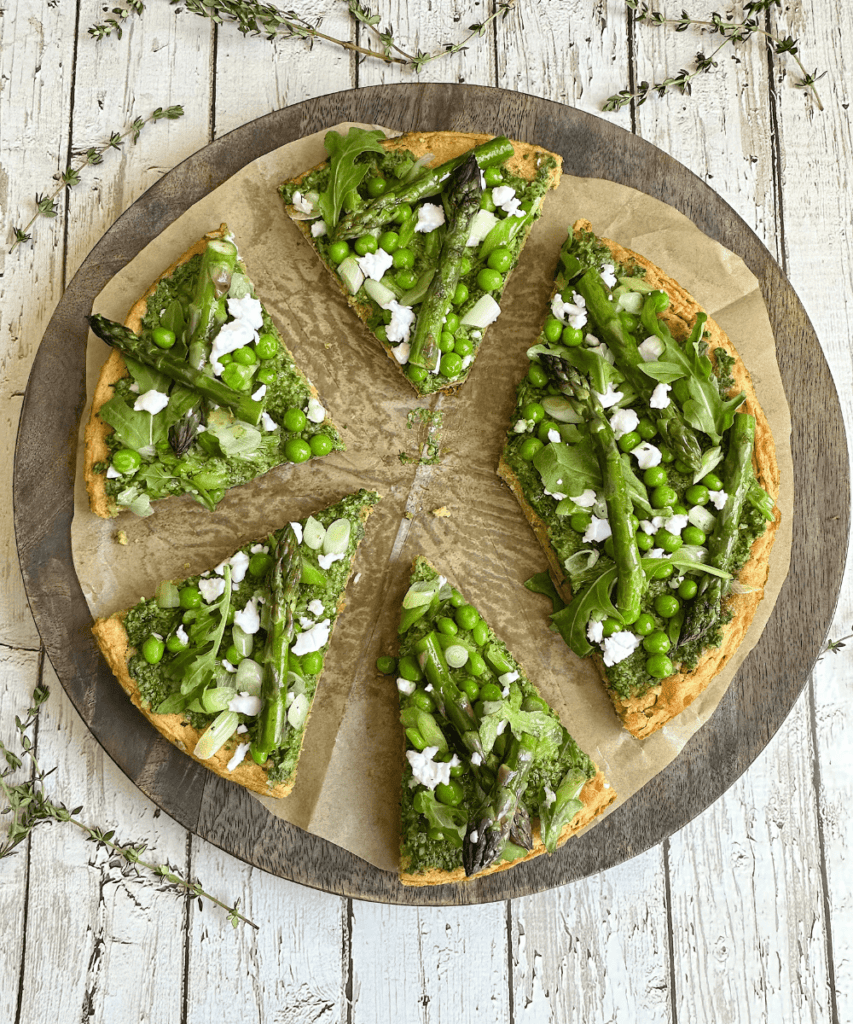
What exactly is socca?
Socca originates from Nice, France, and the neighboring Italian coastline of Liguria. These wedges of wood-fired batter (a combination of a pancake and flatbread) are simple yet delicious and made from chickpea flour, water, salt, and olive oil.
Socca is considered street food in these regions and is often doused in olive oil and sea salt. In Italy it goes by ‘farinata’, ‘torta di ceci’ or ‘cecina’ and often served as an alternative to focaccia.
If you don’t have a wood-fired oven (most of us don’t), then use a cast-iron skillet to bake your socca in.
The key is to throw your pan in the oven while it pre-heats so you create the same even and high heat produced by a wood fire oven, this way the socca becomes nice and crispy on the outside, and still nice and soft on the inside.
And make sure to use high-quality olive oil! Or the Niçoise or Italians might throw a fit, as will I 🙂
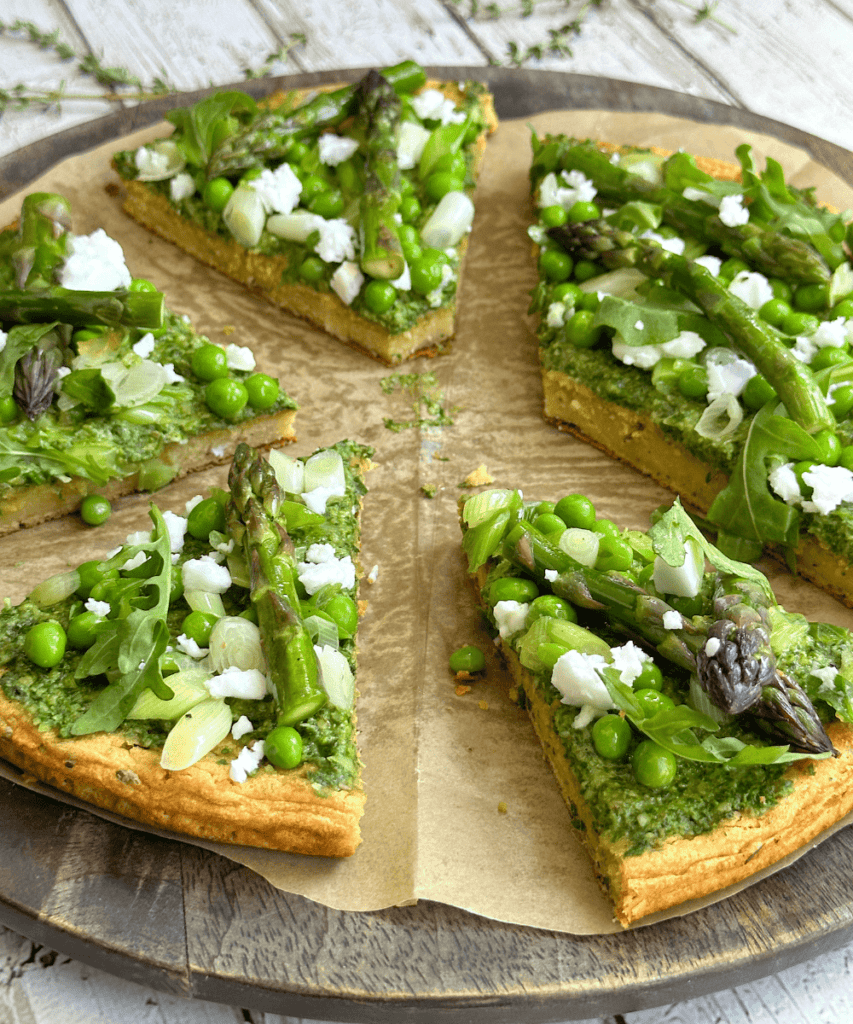
How is socca served?
Socca can be served as an appetizer, or as a light and casual lunch, often accompanied with a glass of rosé wine. You can top the socca with whatever you like and get creative with it depending on the season.
For this post since we are still in spring, I chose to spread it with a spring pesto that I made from a combination of parsley, mint, basil, arugula and spinach with a good amount of lemon juice.
Then I grilled some asparagus and scallions and threw on some lightly blanched peas and sprinkled with a little vegan feta (goat cheese would be nice here too). Simple yet looks impressive and tastes superb!
Wine Pairing Recommendations
I had to go the traditional route here of selecting a rosé (‘tis the season) and I chose to pair them with two, not one rosé just because I can never make my mind up about just one wine. I picked two different vintages, one from the current one, 2022, and one from last year.
I’m not obsessed about always picking the latest vintage of rosé as wines from many quality producers will become even more interesting with a couple of years on their back.
My chosen ones were:
2021 Domaines Ott By.Ott Rosé
Domaines Ott is owned by Louis Roederer and a super premium producer and pionéer of rose wines since 1912.
Domaines Ott farms organically and this wine is primarily sourced from their estates Château de Selle and Clos Mireille (80%). The cépage is 58% Grenache, 30% Cinsault, 10% Syrah, and 2% Mourvèdre.
Pale pink, delicate, and elegant bursting with bright strawberries, raspberries, and white peach. Touch of fennel and floral notes on both the nose and the palate – classic Provençal in style.
What makes it different from the sea of pale rosés from Provence out there is that it has a depth and a textural feel that tells me this is made well and with care.
I also love their higher-end rosés, which can age for several years, but this is a good introduction to their line-up. You might become as enamored with Domaines Ott as I am after taking a few sips of this!
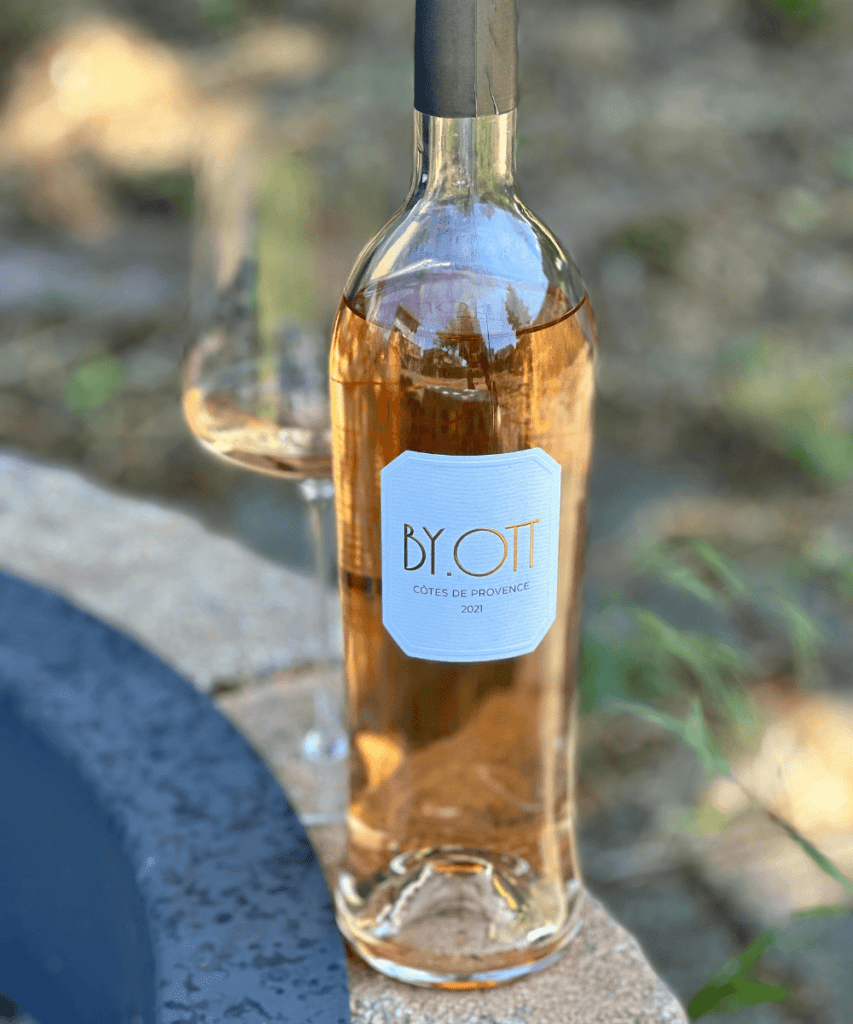
2022 Peyrassol Cuvée des Commandeurs Rosé
Located in the foothills of the Massifs des Maures, Peyrassol is one of Provence’s top wine estates and has produced wine for nearly 800 years.
Like Domaines Ott, this producer also farms organically. Light salmon skin color, the wine has a candied aroma with a touch of rose petals and a delicate palate of juicy red berries coupled with blood orange and honeysuckle flavors.
The cépage here is 40% Grenache, 35% Cinsault, 15% Syrah, and 10% Rolle.
Another classic, high-quality Provençal rosé that is always a pleasure to drink.
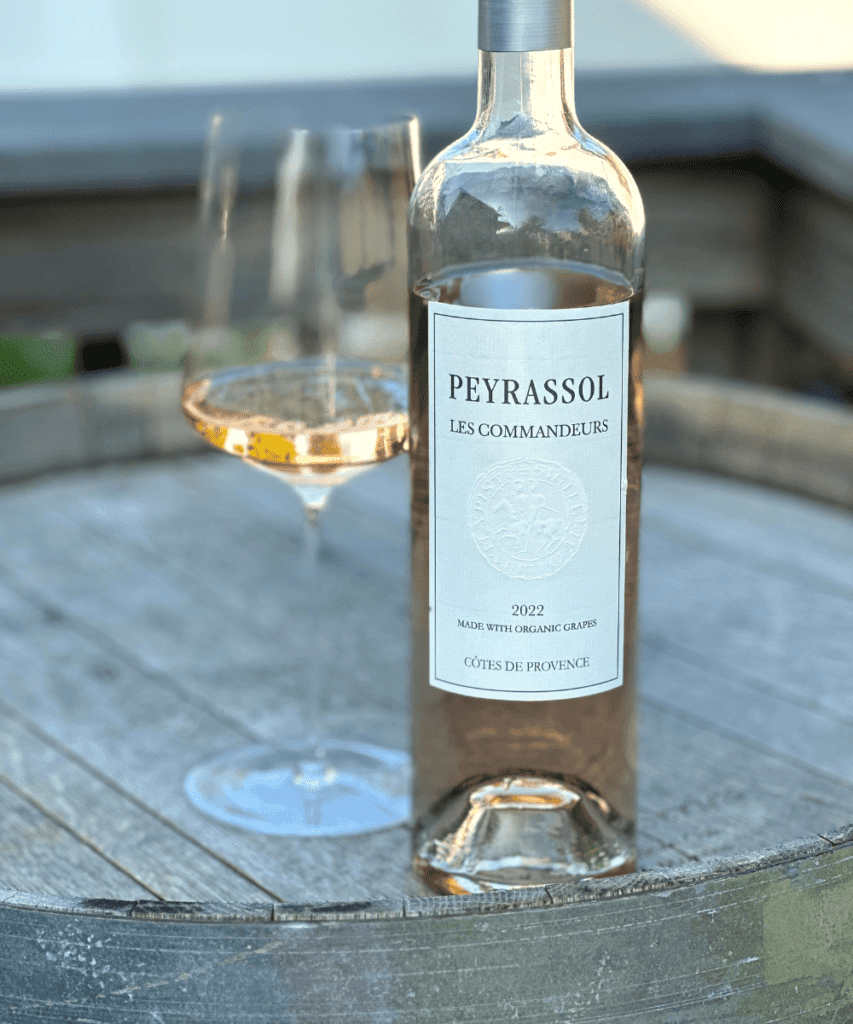
Now all you have to do is get that socca in the oven and pop the rosé and you’ll have a delicious spring /summer meal on your hands, whether it’s for Memorial Day weekend or beyond!
Santé!
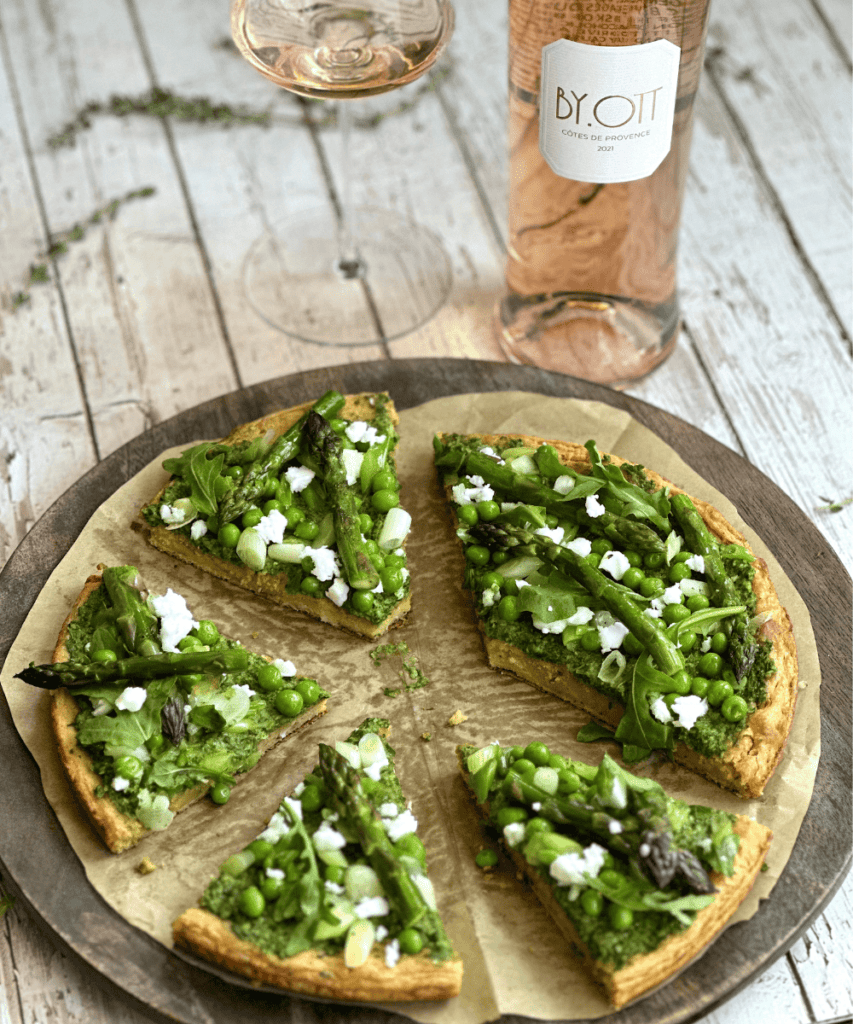
SPRING SOCCA FLATBREAD
Makes 1 x 10-inch flatbread
For the socca:
1 ½ cups (150 grams) chickpea flour
2 heaping teaspoons kosher or sea salt
1 garlic clove, minced
1 heaping tablespoon fresh thyme, chopped
1 ½ cups (3.5 dl) water
3 tablespoons extra-virgin olive oil
Spring Pesto:
1 packed cup mint leaves
1 packed cup basil leaves
1 packed cup parsley
2 packed cups arugula
1 packed cup spinach
½ cup (60 grams) walnuts
Juice of ½ lemon
½ cup (50 grams) grated vegan parmesan (or nutritional yeast)
½ cup (125 ml) extra-virgin olive oil
Salt, and pepper to taste
Topping:
1-2 tablespoons olive oil
1 bunch scallions, sliced thin, white and light green parts only
1 cup fresh or frozen peas, blanched and /or thawed
1 bunch asparagus, trimmed and sliced
Juice from ½ lemon
½ cup (75 grams) vegan feta or goat cheese
Handful of arugula leaves
To make the socca:
Add the chickpea flour, salt, thyme, and minced garlic clove in a medium bowl and whisk to combine.
Drizzle in the water and olive oil and whisk until no streaks of flour are left. Set aside to rest for a minimum of 30 minutes, up to a couple of hours.
Meanwhile, preheat your oven to 450℉ (225℃). Place a 10-inch (25 cm) cast-iron skillet in the middle rack of the oven while the oven preheats to get the pan hot as well.
Once the oven is ready, remove the skillet from the oven and drizzle in a little more olive oil, swirling the pan to coat it evenly. Pour in the prepared batter and place back in the oven and cook for about 30 minutes until the edges are set and it’s golden up top.
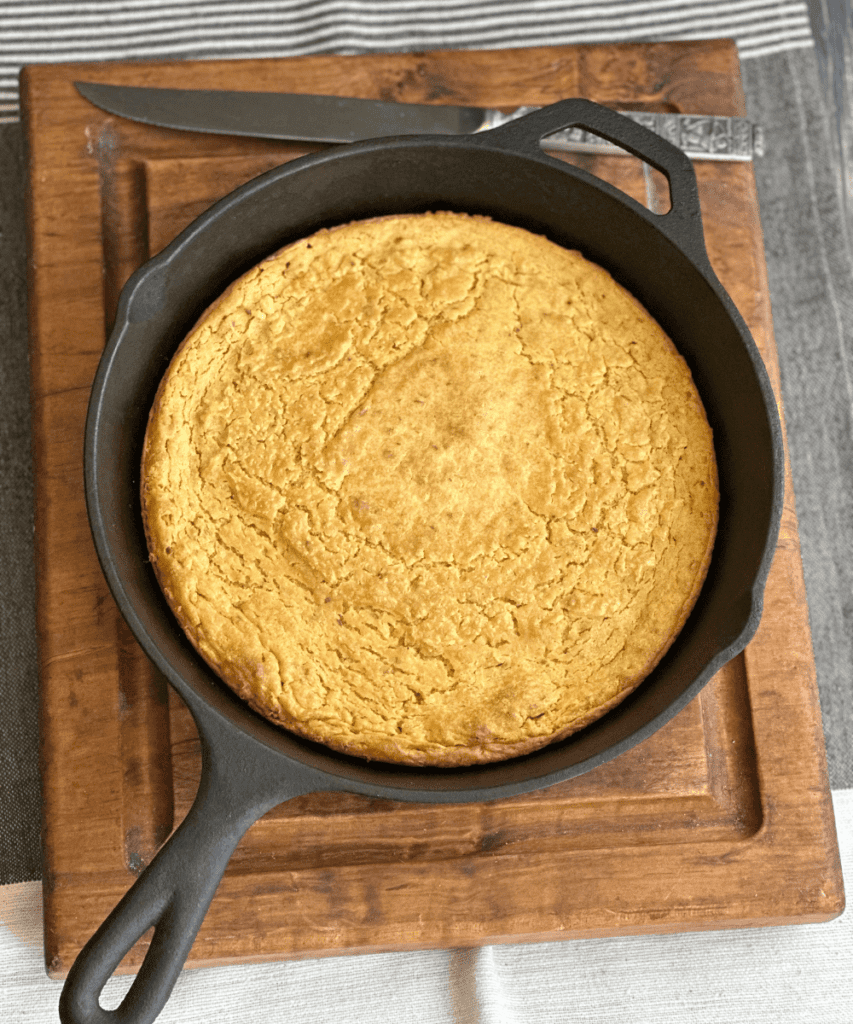
While the socca is in the oven, prepare the spring pesto:
Add all the ingredients minus the olive oil to the bowl of a food processor and pulse until homogenous.
With the motor running, slowly drizzle in the olive oil until it’s all incorporated and you get a nice paste.
Season with salt and pepper.
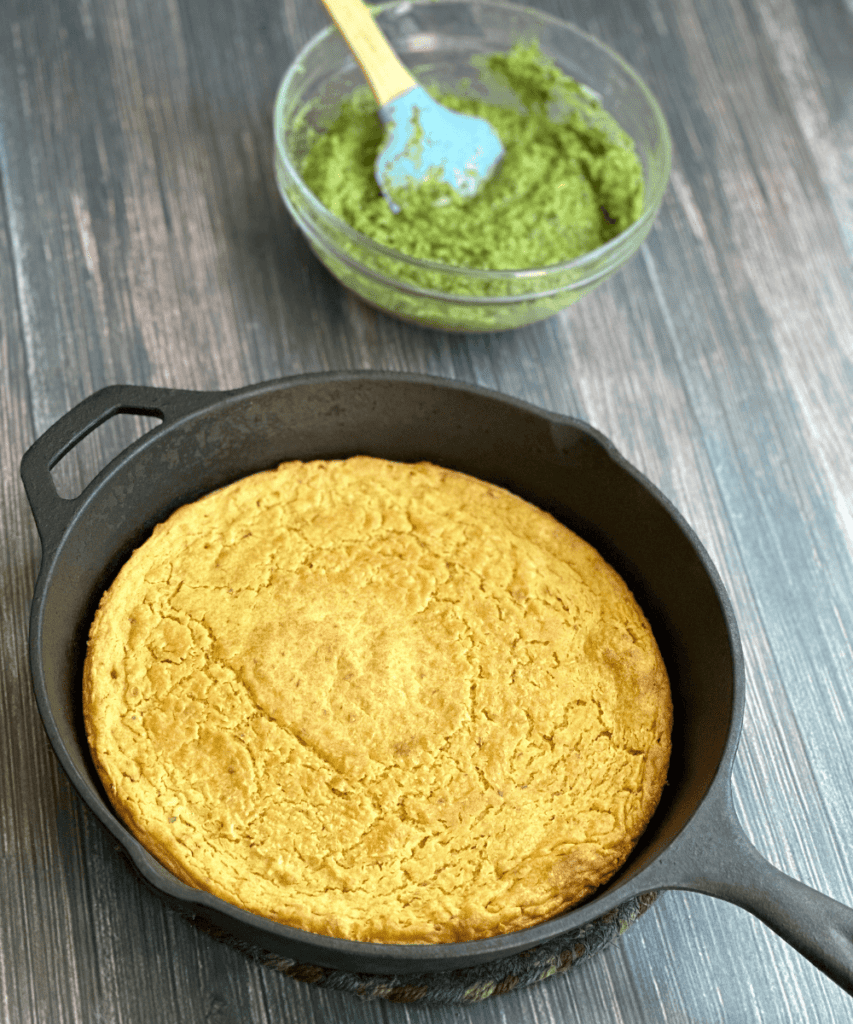
Then prepare the topping:
Heat up a medium or large skillet over medium heat, add a tablespoon of olive oil then the scallions with a pinch of sea salt, and cook for a minute or two until they start to turn translucent.
Throw in the peas and saute just for a few seconds until heated through and then remove from the heat and place onto a sheet pan to cool off. This is important because you want to keep the vibrant green color of the peas (nobody wants brown-looking, overcooked soggy peas!).
Add a little more olive oil to the pan then throw in the asparagus with a pinch of salt and saute for a couple of minutes, then squeeze half a lemon over the veg and cook for another minute before removing from heat and transferring to the sheet pan with the scallion-pea mixture.
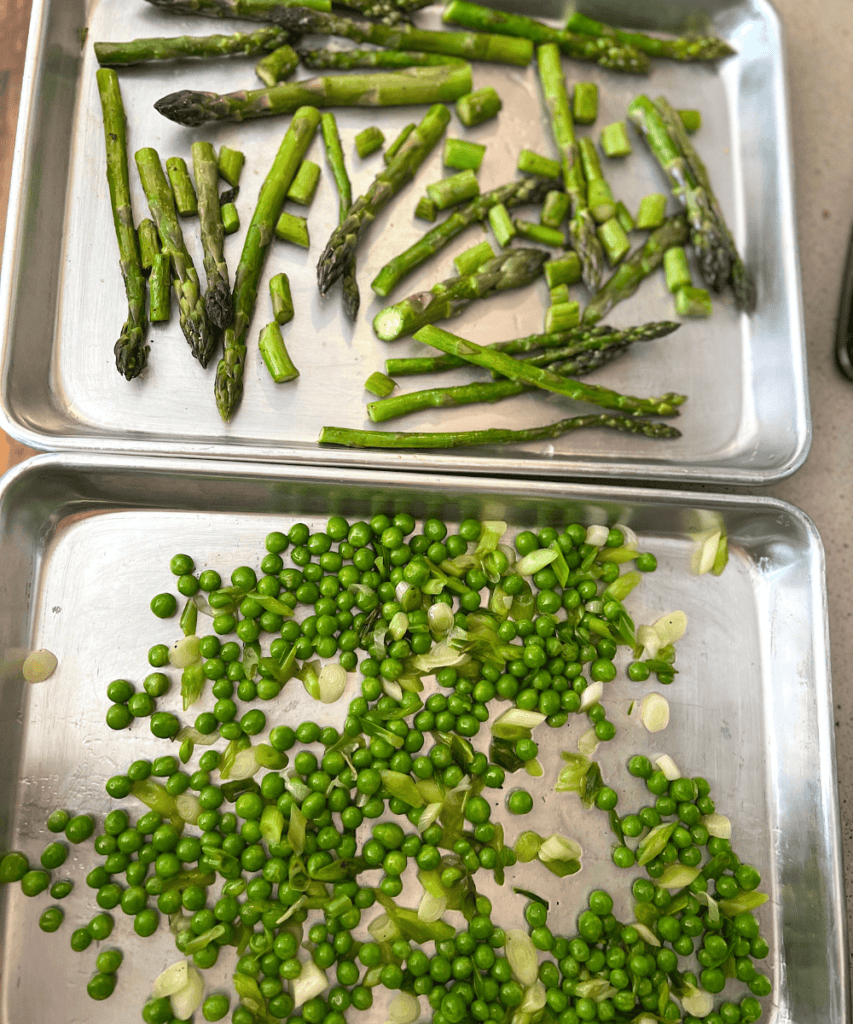
Assemble the socca:
Place the socca on a serving plate or board, spread with a generous amount of the spring pesto, then garnish with the sautéed scallions, peas, and asparagus, and top with a few arugula leaves and the vegan feta or goat cheese.
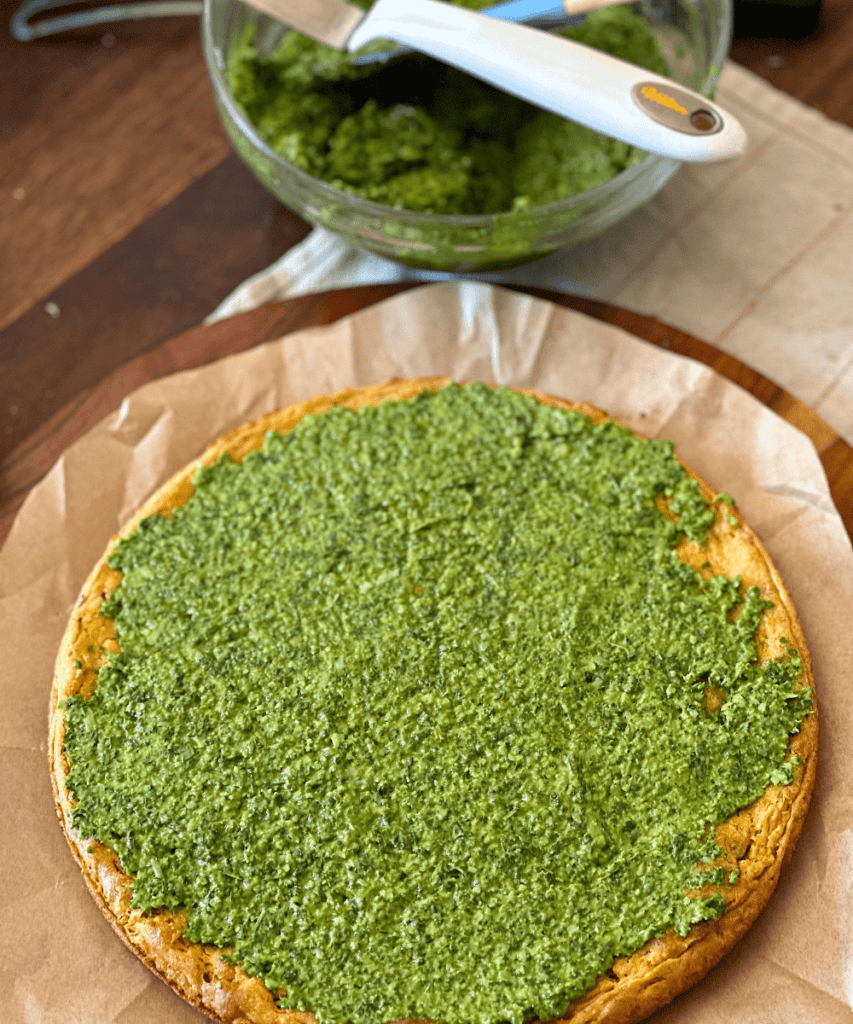
Serve immediately with a glass of rosé!
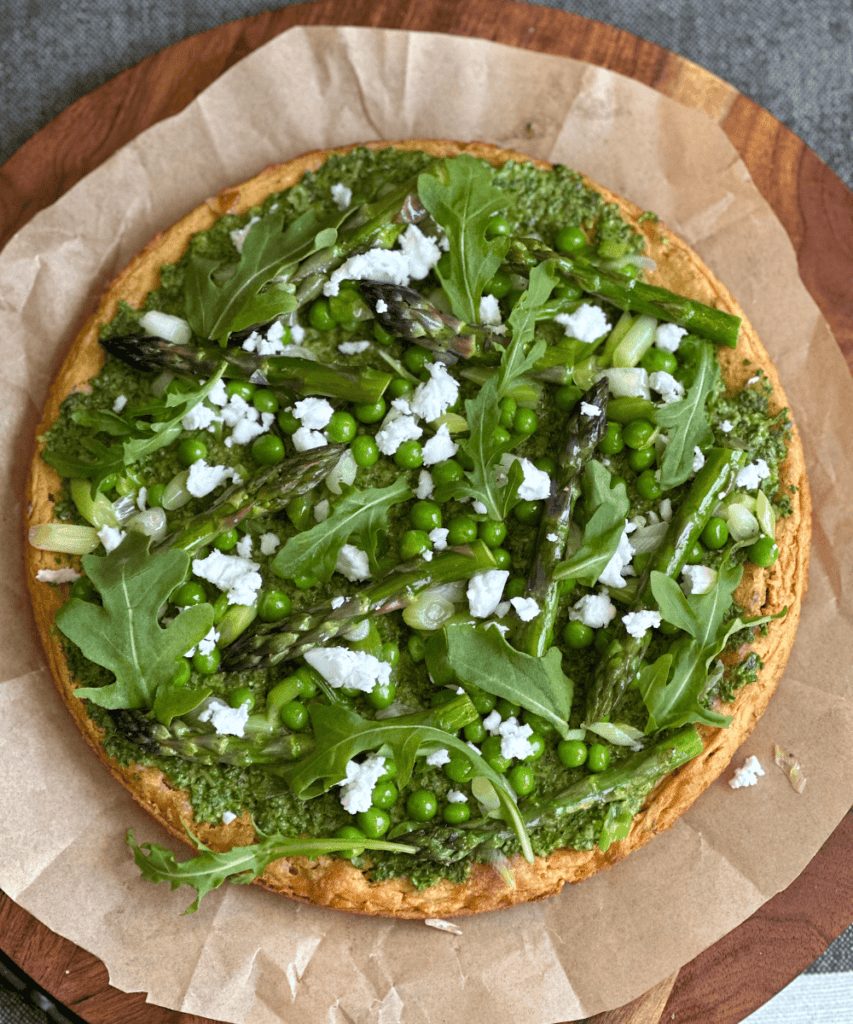
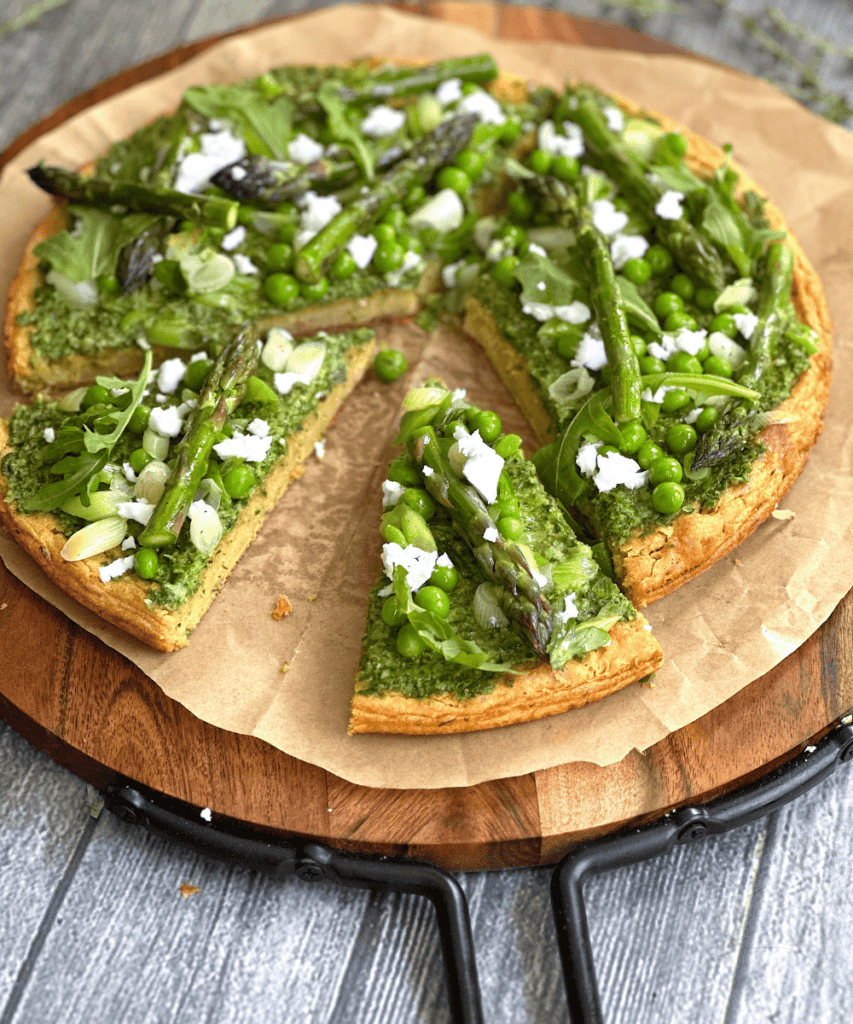
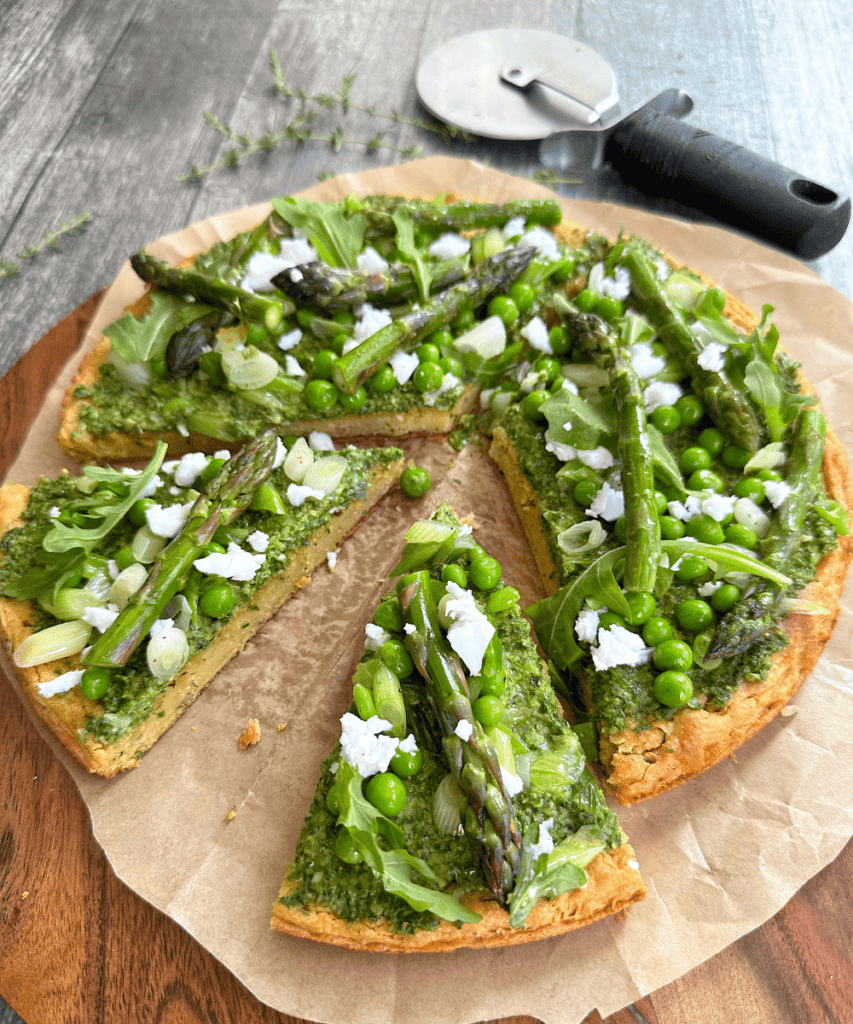
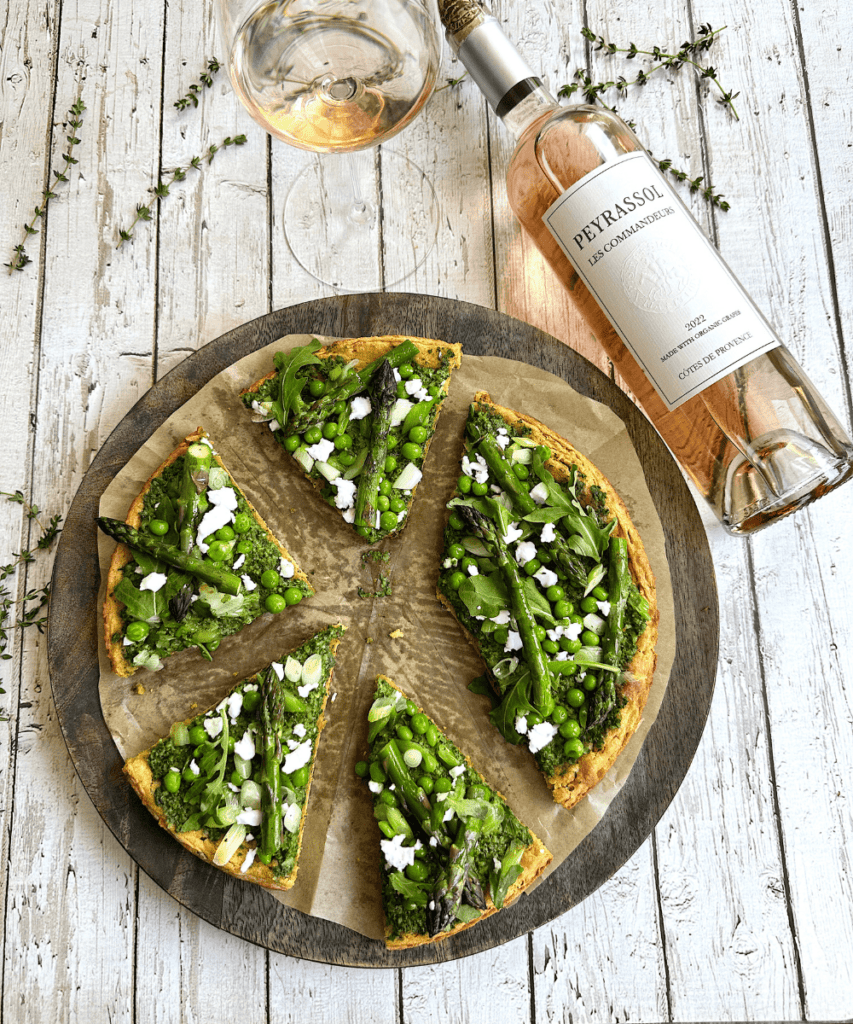
Spring Socca Flatbread
- Yield: 1 x 10-inch flatbread
- Category: Main
Ingredients
For the socca:
1 ½ cups (150 grams) chickpea flour
2 heaping teaspoons kosher or sea salt
1 garlic clove, minced
1 heaping tablespoon fresh thyme, chopped
1 ½ cups (3.5 dl) water
3 tablespoons extra-virgin olive oil
Spring Pesto:
1 packed cup mint leaves
1 packed cup basil leaves
1 packed cup parsley
2 packed cups arugula
1 packed cup spinach
½ cup (60 grams) walnuts
Juice of ½ lemon
½ cup (50 grams) grated vegan parmesan (or nutritional yeast)
½ cup (125 ml) extra-virgin olive oil
Salt, and pepper to taste
Topping:
1-2 tablespoons olive oil
1 bunch scallions, sliced thin, white and light green parts only
1 cup fresh or frozen peas, blanched and /or thawed
1 bunch asparagus, trimmed and sliced
Juice from ½ lemon
½ cup (75 grams) vegan feta or goat cheese
Handful of arugula leaves
Instructions
To make the socca:
Add the chickpea flour, salt, thyme, and minced garlic clove in a medium bowl and whisk to combine.
Drizzle in the water and olive oil and whisk until no streaks of flour are left. Set aside to rest for a minimum of 30 minutes, up to a couple of hours.
Meanwhile, preheat your oven to 450℉ (225℃). Place a 10-inch (25 cm) cast-iron skillet in the middle rack of the oven while the oven preheats to get the pan hot as well.
Once the oven is ready, remove the skillet from the oven and drizzle in a little more olive oil, swirling the pan to coat it evenly. Pour in the prepared batter and place back in the oven and cook for about 30 minutes until the edges are set and it’s golden up top.
While the socca is in the oven, prepare the spring pesto:
Add all the ingredients minus the olive oil to the bowl of a food processor and pulse until homogenous.
With the motor running, slowly drizzle in the olive oil until it’s all incorporated and you get a nice paste.
Season with salt and pepper.
Then prepare the topping:
Heat up a medium or large skillet over medium heat, add a tablespoon of olive oil then the scallions with a pinch of sea salt, and cook for a minute or two until they start to turn translucent.
Throw in the peas and saute just for a few seconds until heated through and then remove from the heat and place onto a sheet pan to cool off. This is important because you want to keep the vibrant green color of the peas (nobody wants brown-looking, overcooked soggy peas!).
Add a little more olive oil to the pan then throw in the asparagus with a pinch of salt and saute for a couple of minutes, then squeeze half a lemon over the veg and cook for another minute before removing from heat and transferring to the sheet pan with the scallion-pea mixture.
Assemble the socca:
Place the socca on a serving plate or board, spread with a generous amount of the spring pesto, then garnish with the sautéed scallions, peas, and asparagus, and top with a few arugula leaves and the vegan feta or goat cheese.
Serve immediately with a glass of rosé!


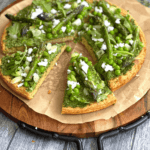

0 Comments